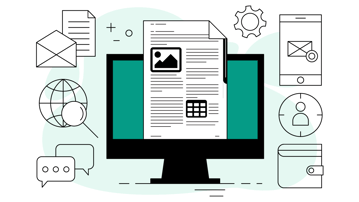There are a large number of very specific requirements, each with their own interdependencies, and there is rarely just one right response. Then there’s the proposal or bid package itself; a set of documents with a large number of pages and specifically outlined sections, each with their own narrative, images, charts, figures and tables, that must comply with strict government formatting regulations.
How can you possibly streamline this complex, time-consuming and cost-laden process and keep bidding winning proposals?
Here are three time-saving tactics for streamlining your complex government proposal process, optimizing your resources and increasing your volume.
Make Your Bid Team More Effective
You want to bid more government proposals and you want to win more government contracts. Stretch your staff just right, and they can work miracles. Stretch them too thin, and your process goes off the rails. That means last-minute sprints that threaten compliance and quality, and bottlenecks and delays that threaten deadlines.
How do you stretch your team without breaking them? Co-authoring fine-tunes your staffing plan to support your growing workload.
- Save Time. Working together on the same document at the same time eliminates the “wait to work” and saves valuable expert time. Just be sure you're automatically tracking versions, changes and updates to your Solution Overview and Implementation Plan.
- Accelerate Work. Working together also means your content reviews can work in parallel with your content creation, expediting your process without sacrificing quality. Just be sure your writers and reviewers are on the same page with what content is expected in your Executive Summary and Technical Overview.
- Do More. Once your content reviews and content creation are working in parallel, suddenly large portions of your proposal are landing in the “approved” bucket faster, paving the way for a calm, seamless production. Just make sure that interdependencies between your Solution Checklist and Pricing are kept in check.
Don’t risk proposal staff burn-out, turnover and lost opportunity. Do more with your same staff with the time-saving power of co-authoring.
Develop Strong Proposal Managers
Government contractors designate proposal managers, yet these proposal managers rarely manage the people who write and review the proposals they manage. This often causes a dangerous miscommunication gap between “what is asked for” and “what is delivered”. One that can’t be bridged with phone calls, voicemails and emails.
How do you give your proposal manager the insights they need to bridge the gap? To keep proposal projects moving forward and unlock time and cost-savings? Dynamic, real-time visibility into status and progress keeps the team in sync and on track with content milestones, and accountable.
- Simplify Tasks. Providing contributors with a centralized view of their tasks, including deadline, urgency, comments, and a direct link to the content, keeps their responsibilities top-of-mind. And your finger on the pulse of progress and status.
- Easily Reallocate. A centralized view of comprehensive proposal content, including progress status, keeps your eye on the ball. Now you know what’s progressing and what’s stalled and can quickly step-in, reallocate resources, and avoid any impact on interconnected content.
- Eliminate Delays. A centralized view of who is working on a document means you now know who is struggling. And you can quickly reach-out to support team members who may need assistance, and avoid disrupting the next deadline.
Don’t risk missed deadlines, poor quality issues and lousy win rates. Develop responsible, can-do proposal leaders with real-time visibility into your process, progress and status.
Suggested content



Get More From Your Subject Matter Experts
Your government proposal may look good and read well, but if it’s not clearly in response to fulfilling the government’s needs, the evaluation committee will not give it the score you are working towards. On the other hand, when your proposal maturity and quality includes expert insights and context, it will better convince the evaluation committee that your solution solves the specific problem, is the best fit, and you are the right and fair vendor selection.
You can’t do that without your subject matter experts. And they can’t do that without direction and time to think and write.
How do you leverage your subject matter experts without negatively impacting their other responsibilities?
- Content Access. Easy, filterable access to everything your subject matter experts have written in the past is a huge time-saver. Instead of wondering where they wrote that before, or searching email and hard drives, they find what they need to get started. And invest their time using their government expertise to tailor content to the specific opportunity and customer.
- Expert Network Access. With co-authoring, your subject matter experts are never working alone. Their colleagues are just a comment away, whether they need to clarify a detail or ask for more information. Instead of losing track of these conversations in email, these conversations are part of the documents they’re writing, so they stay on top of what needs to get done, and you stay on top of if it’s been done.
- Auto-Format. Formatting focuses your subject matter expert’s time, and makes your proposal easier to read, understand and accept. Yet, keeping your formatting correct while writing is a time-consuming distraction. Take formatting out of the hands of your subject matter experts. Instead of worrying about indenting paragraphs and adding bullets, they’ll use their mental bandwidth to focus on the task at hand; writing the content you need to convince the evaluation committee.
Don’t get caught with missing or inaccurate content and a last-minute sprint to fill the gaps. Save time, advance your content maturity and your proposal winnability with centralized content and expert collaboration.
You’re a busy government contractor and you can’t do it alone. Using these tactics will streamline your complex government proposal process, save time, optimize your resources and reduce costs so that you can win and grow!









